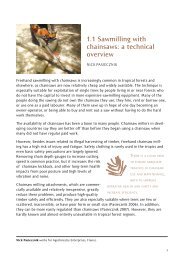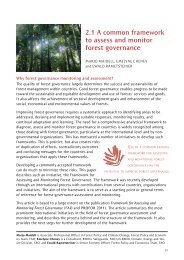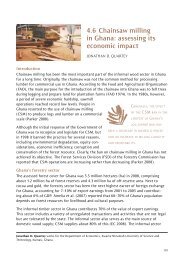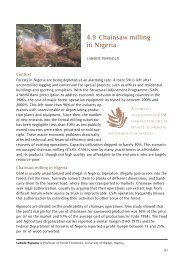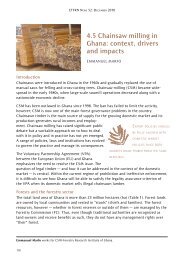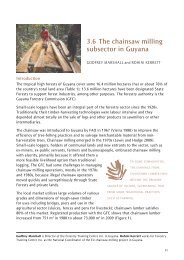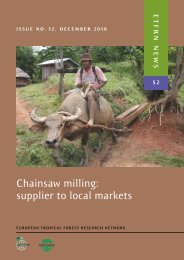Chainsaw milling: supplier to local markets - European Tropical ...
Chainsaw milling: supplier to local markets - European Tropical ...
Chainsaw milling: supplier to local markets - European Tropical ...
You also want an ePaper? Increase the reach of your titles
YUMPU automatically turns print PDFs into web optimized ePapers that Google loves.
4.10 chaiNsaw milliNg aND RaiNFoREsT DyNamics iN souThERN NigERia<br />
The post-independence military incursion in<strong>to</strong><br />
political governance significantly altered the<br />
structure of the state and private sec<strong>to</strong>r<br />
cooperation <strong>to</strong>wards sustainable forest<br />
management through long-term forest<br />
concessions. The 100-year rotation that<br />
operated in what was the midwest region<br />
(now Edo and Delta states) and western<br />
region (lagos, oyo, ogun, Ekiti, ondo and osun<br />
states) was replaced with a 25-year felling cycle;<br />
it was subsequently reduced again <strong>to</strong> five-year<br />
and then three-year rotations respectively.<br />
he primary objective of long-term concessions<br />
was <strong>to</strong> maintain the ecological integrity of<br />
production forests through sustained yield<br />
Figure 1.<br />
administrative map of Nigeria<br />
management by encouraging partnerships between concessionaires and the state. To<br />
achieve this goal, concessionaires had the mandate <strong>to</strong> prepare working plans and carry<br />
out forest inven<strong>to</strong>ries and a few development activities within the concessions; the state<br />
performed moni<strong>to</strong>ring and advisory work.<br />
The 1999 constitution of the Federal republic of nigeria places the protection of the<br />
environment and of air, water and land — including forests and wildlife — under state<br />
governments. The 2006 national Forestry policy was the first stand-alone document <strong>to</strong> be<br />
produced through a participa<strong>to</strong>ry process.<br />
The principles underlying the 2006 forest policy are designed <strong>to</strong> address forest decline,<br />
streamline the contribution of forests <strong>to</strong> economic development, mobilize community and<br />
civil society <strong>to</strong>ward forestry development, address transparency in the tendering of forest<br />
concessions, promote partnership with the private sec<strong>to</strong>r, seek international cooperation,<br />
engender forest policy initiatives, and mainstream forestry in<strong>to</strong> the millennium<br />
Development Goals. as laudable as the policy is, however, it has not yet been put in<strong>to</strong><br />
effect because the National Forestry Act, which is supposed <strong>to</strong> harmonize/streamline the<br />
different state’s forestry laws and edicts, has not been passed by the national assembly.<br />
in the absence of the Forestry Act, the 1988 national agricultural policy — which<br />
subordinates forestry and allied matters — is still operational. The 1988 policy considers<br />
the forestry sec<strong>to</strong>r an appendage of the larger agricultural sec<strong>to</strong>r, making its valuation<br />
and overall contribution <strong>to</strong> GDp difficult <strong>to</strong> capture.<br />
in a few rainforest states, such as ondo, osun and Cross river (where the government is<br />
involved in collaborative arrangements with <strong>local</strong> communities in the management of<br />
forest resources), chainsaw <strong>milling</strong> (Csm) is backed by law in off-reserve areas and<br />
permits are issued on a stumpage or single-tree basis. Generally, there is pervasive abuse<br />
of the single permit process: chainsaw millers surreptitiously obtain multiple owner’s<br />
consent from traditional institutions as well as permits/licences from the forestry departments<br />
for use by the same or different millers in the same or adjoining areas. This offers<br />
189



